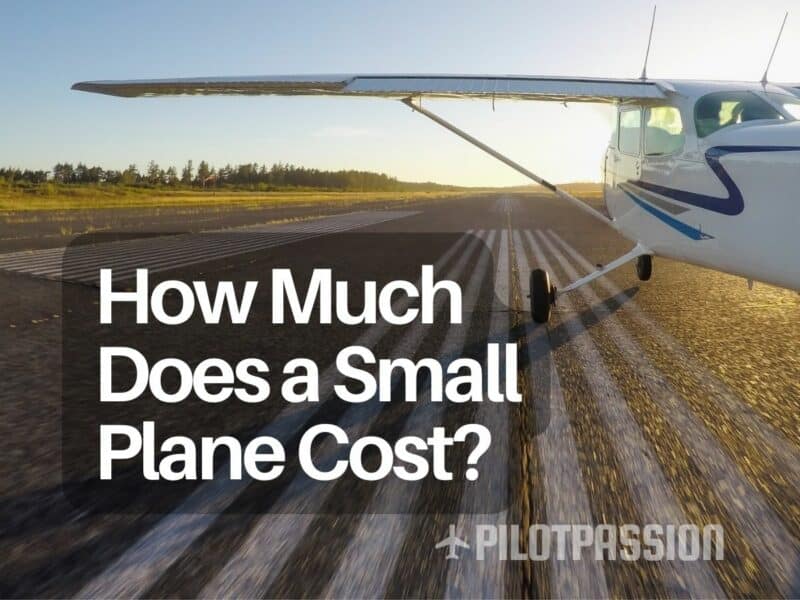Venturing into the realm of personal aviation is a dream many aspire to, and surprisingly, it’s more attainable than you might think. The market for small planes is as varied as the skies they traverse, offering a range of options that cater to different budgets and flying ambitions. Whether you’re aiming for leisurely weekend flights, exploring remote destinations, or fulfilling a lifelong passion for piloting, owning a small plane is a gateway to unparalleled freedom and adventure.
How Much Does a Small Plane Cost? Small plane costs vary: single-engine pistons ($15K-$500K), twin-engine pistons ($100K-$1M), turboprops ($1M-$4M), and light jets ($500K-$9M). Factors include type, age, and condition.
Don’t forget financing and maintenance. Renting may suit you better than buying.

Table of Contents
How Much Does a Small Plane Cost? What You Need to Consider
Escape commercial flights with private planes, avoiding delays and passenger conflicts. Some even get pilot’s licenses. Explore small plane costs and long-term worth.
What Do Specific Types of Smaller Planes Cost?
Purchase price often tops minds when evaluating small plane expenses. Smaller planes can be more budget-friendly.
Ultralight Costs
Ultralight planes are single-seat, short-distance flyers, cost around $8,000-$15,000.
Single-Engine Piston Aircraft
They’re usually the most affordable, ranging from $15,000 to $100,000 used, and $200,000 to $500,000 new. Examples include: Cessna 150, Cessna 172, Cessna 182, Diamond DA40 and Circus SR20.
Twin-Engine Piston Aircraft
Used twin-engine piston planes: $100K-$300K. New ones: $600K-$1M. Examples include: Beechcraft 58 Baron, Cessna 310 and Cessna 337H II Skymaster.
Turboprop Aircraft
Turboprops offer higher performance and cost more. Used: $1M-$2M, new: up to $4M.
Light Jet
Light jets are at the top of “small planes.” Used: $500K-$3M, new: $3M-$9M.
Example: Cirrus Vision Jet.
Financing for Buying Planes
Plane loans, like auto loans, ease high purchase costs. Borrowing varies, so research options. A bigger down payment can lead to lower rates.
What Are the Maintenance Costs for Small Planes?
Small plane ownership, like other vehicles, has costs, albeit somewhat higher. Hangared or not, anticipate potential maintenance expenses.
The following are some of the costs you may need to consider:
Hangar Fees
A hangar is necessary unless you own enough land to keep your plane when grounded. When you use a hangar, you will want to expect to pay at least $250 a month.
Annual Inspections
Annual inspections with authorized inspectors ensure that your plane is flight worthy. Fees vary by the inspector but usually cost $600-$1,200 yearly.
Fuel Costs
Jet fuel prices vary by location, often costlier than auto gas. In Q1 2023, it averaged $6 per gallon. Your plane size and distance affect fuel expenses.
Insurance
Mandatory aircraft insurance offers liability protection for property damage. Costs range from $500 to thousands annually, depending on the plane’s value.
Standard Costs
Plane ownership involves crucial maintenance. Plan for unexpected repairs and routine expenses like oil changes when budgeting.
What About Renting a Plane?
Air travel frequency affects renting versus buying choice. Owning suits frequent flyers, like 100+ annual hours.
Planning a lavish trip? Uncover the real expenses of private jet rentals and decide if it’s for you.
How Do You Figure Your Monthly Ownership Costs?
Standard upkeep costs vary but can be budgeted. Start by knowing your monthly financing payment. Saving for unexpected expenses prevents frustrating situations.
What Are the Estimated Costs of Plane Ownership?
The total cost of plane ownership is a combination of the initial purchase price and annual maintenance and operating costs.
Ultralight planes have average annual costs of $2,000-$5,000. Single-engine planes have higher prices of $22,000-$35,000, and multi-engine planes are the most expensive, at $400,000-$700,000.
What is the Most Affordable Way for You to Fly?
Travel frequency decides if buying a plane is worthwhile, especially for frequent flyers who prefer private travel.
What is the Best Small Plane to Buy?
When it comes to purchasing your own small plane, the myriad options may seem overwhelming.
Let’s delve into some specific categories and models that have caught the attention of pilots and enthusiasts alike.
Light-Sport Aircraft (LSA)
Light-Sport Aircraft offers a delicate balance of performance and affordability, making them a favorite among new and seasoned pilots.
- Cessna 162 Skycatcher: Known for its ease of handling and maintenance.
- Piper Sport Cruiser: Offers excellent fuel efficiency with a sleek design.
Ultralight Planes
For those seeking the thrill of flight without a hefty price tag, Ultralights present a unique opportunity.
- Quicksilver MXL: Renowned for its stability, offering a great entry point for beginners.
- Aerolite 103: A single-seat marvel that provides affordability without sacrificing performance.
Safety and Modern Features
When it comes to safety and cutting-edge technology, some small planes stand out.
- Cirrus SR22: Equipped with a whole-aircraft parachute system and advanced avionics.
- Diamond DA40: Known for its strong safety record and fuel-efficient engine.
The Balance of Cost and Quality
For those who seek a blend of affordability and reliable performance, these models should be considered:
- Beechcraft Bonanza: A timeless classic known for its durable design and resale value.
- Van’s RV-12: A popular kit plane allowing customization to fit individual needs and budget.
I’ve created a detailed analysis of how much specific small planes cost. Here you go!
The small plane market offers diverse options, suiting various preferences and needs. Each pilot’s choice reflects their unique aspirations, from joy to technology. Find your perfect plane for your skyward journey.

Final Thoughts
Navigating aircraft pricing may seem daunting, but the sky’s not the limit for your flight dreams. Budget wisely, and owning a small plane can be thrilling.
Here’s to clear skies and tailwinds on your aviation adventure!